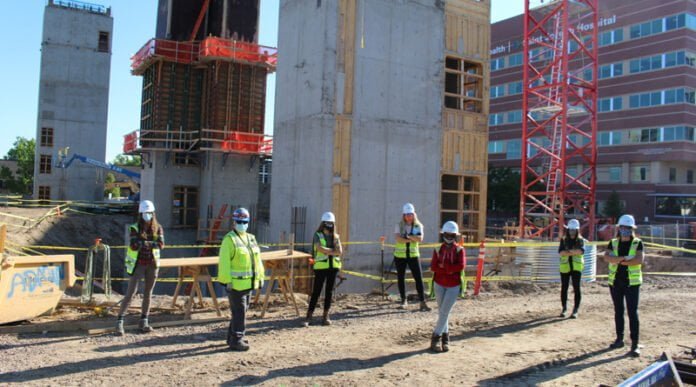The pandemic’s asymmetrical impact on unemployment means there’s a huge pool of potential workers who don’t know what this industry has to offer
With an insidious pandemic, precipitous economic decline and ballooning unemployment, 2020 was one for the record books. As the effects of this unprecedented confluence continue rippling across the country, the business and social norms everyone took for granted are now longed-for luxuries. Many companies were forced to furlough or lay off employees, while others—particularly those relying on in-person services like restaurants and bars—shuttered their doors permanently. As a result, an alarmingly disproportionate number of otherwise hardworking women and members of minority communities suddenly find themselves out of work through no fault of their own.
RELATED: Unemployment Continues to Haunt Colorado
Though not entirely immune to the effects of COVID-19, the construction industry’s early designation as an essential business certainly helped. Even as national unemployment soared to 14.8% in Q2 of 2020, according to the Bureau of Labor Statistics, some 223,000 to 246,000 construction jobs remain unfilled, a figure bizarrely unchanged from the pre-pandemic unemployment rate of 4.1%.
With so many people in the market for meaningful work, it’s hard to believe 85% (or four of every five) of home builders who participated in a recent National Association of Home Builders and Wells Fargo survey cited a paucity of qualified laborers as their biggest challenge when only a decade ago (2011), just 11% of respondents reported it as a concern. But aging does eventually take its toll, so as more veteran construction workers retire faster than they can be replaced, this industry anemia will only intensify if something isn’t done to revitalize the workforce.
“It seems the industry is at a tipping point,” noted Sarah McDaniel, marketing strategist and rainmaker for Denver-based Business Appliance Center & Ferguson Enterprises. “You can sense the changes in how things have ‘always been done’ as advances in technology and a skilled labor shortage have created an environment ripe for innovation. Innovation often comes from diversity in thought, background and experience, so this is an essential time to bring diversity into our workplaces.”
Opportunity often lies where change and challenge intersect, so with so many Americans unemployed, underemployed, or overworked in a scramble to pay the bills, the pandemic reveals an obvious antidote to the industry’s chronic labor shortage: A healthy dose of diversity in the workforce.
A dearth of diversity
Drive by almost any construction site, and odds are it is populated almost exclusively with men, and more pointedly, predominantly white men. To wit, consider these sobering 2020 statistics from the Bureau of Labor Statistics:
- Of all the nation’s construction laborers, 86.6% were white. Forty-six percent were Hispanic, 8% were Black, 3.8% were women and Asian laborers represented a mere 1.4%.
- Not surprisingly, a whopping 91.4% of construction managers were white, while 14.5% were Hispanic, 8.4% were women, 3.3 % were Black and just 2.9% were Asian.
“For a long time—and especially in residential building—the construction industry has been a male-dominated, heavily white generational business,” said Brian Dare, a recruiter at the nonprofit Colorado Homebuilding Academy. “This means people have known each other for decades, and while a tight-knit community is great, it often creates the perception of a wall to people who didn’t grow up with a hammer in their hand.”
As Colorado’s building boom shows no sign of slowing, “if you don’t look beyond those walls to bring in new blood,” added Dare, “you just won’t survive.”
But family ties aren’t the only bricks in those perceived walls. Antiquated racial and gender stereotypes on both sides of the equation also limit industry growth. Most women are still reared to perceive building and repairs as “men’s work,” so perhaps it’s not surprising that in 2020, BLS found that women accounted for just 10.9% of the industry’s workforce, marking only a negligible increase since 2011, when 8.9% of industry workers were women. With construction employment figures for both men and women of color just as dismal, attracting women and minorities to these careers has proven to be no small challenge.
Stereotypes, stigma and school
In addition to the trite gender traditions or ethnic prejudices present in many American homes, until relatively recently, schools did little to expose students to construction and other trade professions. By emphasizing four-year degrees as the best route to a meaningful, well-paying career, both society and academia (perhaps subconsciously) have stigmatized blue-collar work. Apart from leaving students who exhibit greater mechanical or hands-on prowess out in the proverbial cold, the lopsided attention afforded to white-collar professions effectively implied that the skilled trades were less than worthy career aspirations. Fortunately, many schools now recognize that college and a desk job aren’t right for everyone and have begun reintroducing trade-related programs to their curriculum.
“Many individuals who don’t want to go to college after high school finally have opportunities in trade schools that are now opening across the county,” agreed Audree Grubesic, owner of Modular Sure Site, an offsite construction management and consulting service provider. “It’s a slow shift, but we are starting to see schools like the [Colorado] Homebuilding Academy in Denver.”
Education is essential to plugging the construction labor drain, so improved access to training and other opportunities to help those interested in the industry develop careers, regardless of gender, age or ethnicity, is an imperative driving the nonprofit Colorado Homebuilding Academy. Collaborating with builders, trade associations, universities, foundations and schools, the group serves as a resource for classroom lessons, hands-on training, real-world exercises, mentoring, job placement and ongoing support that encourages students from all walks of life to explore a future in the trades or construction.
Interestingly, in addition to working with schools and facilitating youth apprenticeship programs, Dare says those who attend the Academy’s no-cost courses in basic construction, management and concrete skills are typically between the ages of 22 and 45. Some are just starting out, others are looking for a new career, and many are simply seeking better pay, stable hours and work they can be proud of. Since these motives have long been just as relevant to women, the organization developed Women Who Build, a network aimed at attracting women to the various vocations that fall under the construction umbrella, and providing them with the career cultivation, ongoing support and training, access to role models and job placement they need to develop successful careers in this growing industry.
For companies looking to expand the payroll with diverse faces, partnering with groups dedicated to getting more women and minorities in construction such as the Colorado Homebuilding Academy, the National Association of Women in Construction (NAWIC), the Association of General Contractors of Colorado (AGC), the Colorado Contractors Association (CCA) or Build Colorado’s Constructions Careers Now program is a good first step. In addition to providing resources for cultivating inclusive cultures, they can also recommend qualified, diverse candidates to fill open positions.
Diving into diversity
To attract enough fresh blood to ensure business continues to thrive, this year, savvy companies in every aspect of the industry are redoubling efforts to bring more women and people of color into the field. But effecting meaningful changes in company culture won’t happen overnight; it requires plenty of hard work and, critically, unwavering commitment.
“A dedication to inclusion and diversity must become a core value, from leadership all the way down,” emphasized Amy Goffinet, marketing specialist at Taylor Morrison, a national home builder and developer headquartered in Tucson, Arizona. “To pave the way, it’s important to focus on giving women and minorities opportunities; opportunities in the office, opportunities to work in the field and, most importantly, opportunities for them to climb the leadership ladder.”
Indeed, the opportunities that companies create for existing women and POC personnel to advance their careers are just as important as those shaped for new recruits. People who have already broken barriers make it easier for others from similar backgrounds to see themselves in such a position, so encouraging leadership to share their career experiences can have life-changing impacts on others seeking to leverage their own skills and desires into new professions.
“With a woman CEO and three female divisional superintendents, we have up-front and approachable role models,” added Goffinet. “Seeing this type of inclusion in practice goes a long way toward keeping you comfortable even as you’re urged to move beyond your comfort zone.”
Many of the best strategies to cultivate in-house diversity are much like those used to draw POC and women into the vocations, such as providing access to ongoing education, apprenticeships, support networks, women’s career nights and other gender- or diversity-specific events. Still other ways to engage these individuals include job rotation opportunities, as well as highlighting and promoting their success stories and achievements.
Diversity dynamos
Construction and trade firms that have put in the work to develop staffs representing a breadth of different backgrounds do reap dividends.
“Diverse teams are shown to be productive teams,” says Jenny Nowakowski, principal interior designer with residential interior design and architecture firm Indigo Designs Denver, LLC. “Forward-thinking companies understand that unique backgrounds encourage fresh perspectives, innovation and creativity.”
RELATED: Women in Colorado are Shaping an Energy Efficient Future
The better a company becomes at integration, the easier it is to attract and retain diverse recruits. This has certainly been the experience of Mortenson Denver, a national private- and public-sector builder where women comprise an astonishing 34% of the workforce—more than triple the national average. Ten percent of their craftworkers are female, and at least 15% of their subcontracts are awarded to small, minority- or women-owned businesses.
“We have always met the industry standard for diversity, but that’s not good enough,” maintained Kedmia Milam, Mortenson’s craft workforce manager and workforce development lead. “While we certainly don’t see people as numbers, ensuring our percentages of people of color, minority groups and women are above the industry average is a way to hold ourselves accountable to our commitments.”
To maintain its lead, Mortenson’s workforce development program performs a great deal of advocacy and outreach to demonstrate not only what the construction careers really look like (including introductions to trades like carpentry and masonry), but also how rewarding—both financially and emotionally—these professions can be. From supporting schools by conducting mock-up sessions, discussion panels, hands-on construction pours and Q&As to attending career fairs (Mortenson attends Aurora Public School and Jefferson County career fairs even when they’re not actively recruiting) where they distribute marketing and resource materials emphasizing their appetite for diversity and featuring images of their own multicultural workforce, Mortenson is proactive about engagement.
“If you want to create diversity in the construction community, it’s imperative to be visible,” said Christina Zavislan, the company’s senior marketing manager.
And although COVID-19 has put a damper on in-person gatherings, maintaining brand visibility remains attainable via a variety of traditional and technological tools. In addition to tangible marketing collateral such as brochures and mailers, Zavislan finds equal success with social media and other electronic recruiting endeavors.
“Social media plays a more important role at this time,” Zavislan explained, “but we’ve always worked with HR to ensure all job listings demonstrate our commitment to diversity and are published on various platforms. We love to spotlight our people, so LinkedIn is great for sharing our staff’s personal and professional success stories.”
“There will always be challenges to being actively involved in diversifying the construction and crafts industry, but you will find many different ways to go above and beyond,” encouraged Milam. “I’ve even done video interviews with incarcerated people!”
Diversity in building and construction has always been important, but perhaps never more so than now. In addition to making the industry appealing and approachable to young people, women and people of color alike, employers can mitigate community unemployment as well as reduce gender and racial gaps—all while building stronger, more innovative workforces.








